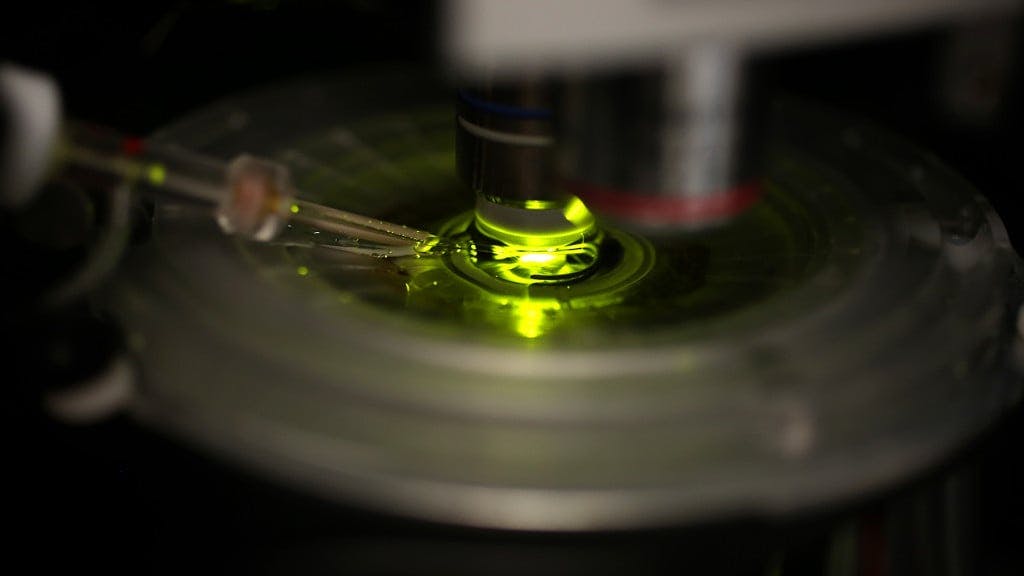
Electrophysiology: What goes on the inside?
By Charleen Salesse
The intracellular solution, as its purpose is to mimic the ionic content of cells, is one of the most important solutions in electrophysiology recordings, yet one of the most difficult to get right. Here, we discuss what this solution should contain when performing electrophysiology experiments on neurons, and how it’s best prepared.
Potassium or caesium?
Intracellular solutions for patching neurons should be potassium ion (K+) based, as the intracellular neuronal concentration of K+ is higher compared to the extracellular concentration. Therefore, one of the major constituents of a pipette solution is usually a potassium salt, commonly in the form of potassium-chloride (KCl), potassium-gluconate (K-gluconate) or potassium-methylsulfate (KMeSO4).
A KCl-based pipette solution minimises liquid-liquid junction potentials which can form at the top of the micropipette (because chloride is a major part of the extracellular solution) and results in lower pipette resistance. However, the resulting high intracellular chloride concentration can cause some GABAA-mediated inhibitory synaptic currents to be depolarising rather than hyperpolarising.
K-gluconate blocks certain K+ channels and can sometimes precipitate and clog the recording pipette, increasing the access resistance over time. Gluconate has also been shown to bind Ca2+ ions with low affinity. This could affect experimental results as a higher influx of Ca2+ will be needed for neurotransmitter release if gluconate is present.
KMeSO4 minimises run-down of calcium-activated potassium currents and preserves neuronal excitability more effectively that K-gluconate. Additionally, access resistance is sometimes lower with KMeSO4, presumably due to the lower series resistance and increased mobility of methylsulfate over gluconate.
Often, caesium is used instead of potassium as a major cation. This reduces the cell membrane’s potassium currents and a better uniformity of the space-clamp is obtained. The bigger size of the caesium ion doesn’t allow it to pass through the pore as it would for potassium. Due to this, once whole cell patching is achieved, there is an increasing block of potassium channels that will cause the cell to depolarise. Traditionally, potassium-based intracellular solutions are used to record firing and to measure synaptic activity, but caesium-based are preferred by several experimenters for the latter as by blocking K+ channels it improves space clamp and allows more stable recording at a more depolarized membrane potential.
Energy
Energy, in the form of adenosine triphosphate (ATP), is an important component of the intracellular solution as it is required for a variety of processes. ATP fuels the Na+/K+ ATPase which maintains the sodium and potassium gradients across the membrane, and is also needed for the recycling of unbound neurotransmitter back to the presynaptic terminal and into synaptic vesicles, as well as for structural repairs to the membrane, proteins and DNA.
If ATP is present, the solution should be kept on ice. Phosphocreatine can be diluted into intracellular solution and metabolised by the neuron to produce ATP.
Guanosine triphosphate (GTP) is also added to the intracellular solution to conserve G protein-mediated responses, for example, some neurotransmitter receptors are G protein-coupled receptors.
Calcium and pH buffers
Small amounts of EGTA (ethylene glycol-bis(β-aminoethyl ether)-N,N,N',N'-tetraacetic acid), a calcium chelator, can also be included to help stabilise the intracellular concentration of free calcium ions. Since BAPTA (1,2- bis(o-amino phenoxy)ethane-N,N,N′,N′-tetra acetic acid) is a much faster calcium chelator than EGTA, BAPTA is preferred when rapid elimination of intracellular calcium build-up is required.
HEPES (4-(2-hydroxyethyl)-1-piperazineethanesulfonic acid)) helps maintain physiological pH. It is highly soluble, membrane impermeable, chemically stable and has a limited effect on biochemical reactions.
For a specific purpose
In order to block action potentials in only the patched cells, sodium channel blockers (such as QX-314) might be added, or barium ions to block Ca2+ channels. Biocytin or fluorescent markers can also be added in order to label cells post hoc.
How to make and stock your intracellular solution
For this, several approaches exist. Yet the first step is always to add all the components as accurately as possible. It is best to use double-distilled H2O as a minimum: the higher the purity, the better. A good practice is to keep a concentrated stock of solely the salt that you will be using, which is then pipetted into the mixture using a calibrated pipette. A trick here to ensure good osmolarity is to only pipette 90% of the main salt (caesium or potassium), you can add it later to adjust the osmolarity. It is preferable to make a larger batch of intracellular solution (~50 ml). Adjust the pH (7.25-7.4) using concentrated either KOH (potassium hydroxide) or CsOH (Caesium hydroxide).
The last step is to measure and adjust the osmolarity. For a good seal, the practice is often to make your intracellular solution have 10-20 mOsm lower than your extracellular solution. A difference greater than that will cause cells to swell. After adjusting the osmolarity, simply aliquot the solution and freeze until use.
Before use, pass the solution through a 0.22 um filter. Once thawed, the solution should be kept as close as possible to 4°C to preserve the integrity of ATP and GTP, which are very sensitive to heat.
How to interpret and reproduce results with different intracellular solutions
Beyond the technical consideration and justification for experimenters to use a specific solution for their work, readers should pay attention to the infinite variety of composition that exists from studies to studies. Such variability can be a serious concern when it comes to comparing, interpreting and reproducing results across time and laboratories.
Scientifica have created a printable PDF guide. Download it here:
Electrophysiology: what goes on the inside?
References:
Skibsted, L.H., and Kilde, G. (1972). Dissociation constant of calcium gluconate. Calculations from hydrogen ion and calcium ion activities. Dansk tidsskrift for farmaci 46, 41-46.
Tsien, R.Y. (1980). New calcium indicators and buffers with high selectivity against magnesium and protons: design, synthesis, and properties of prototype structures. Biochemistry 19, 2396-2404.
Woehler, A., Lin, K.H., and Neher, E. (2014). Calcium-buffering effects of gluconate and nucleotides, as determined by a novel fluorimetric titration method. The Journal of physiology 592, 4863-4875.

)